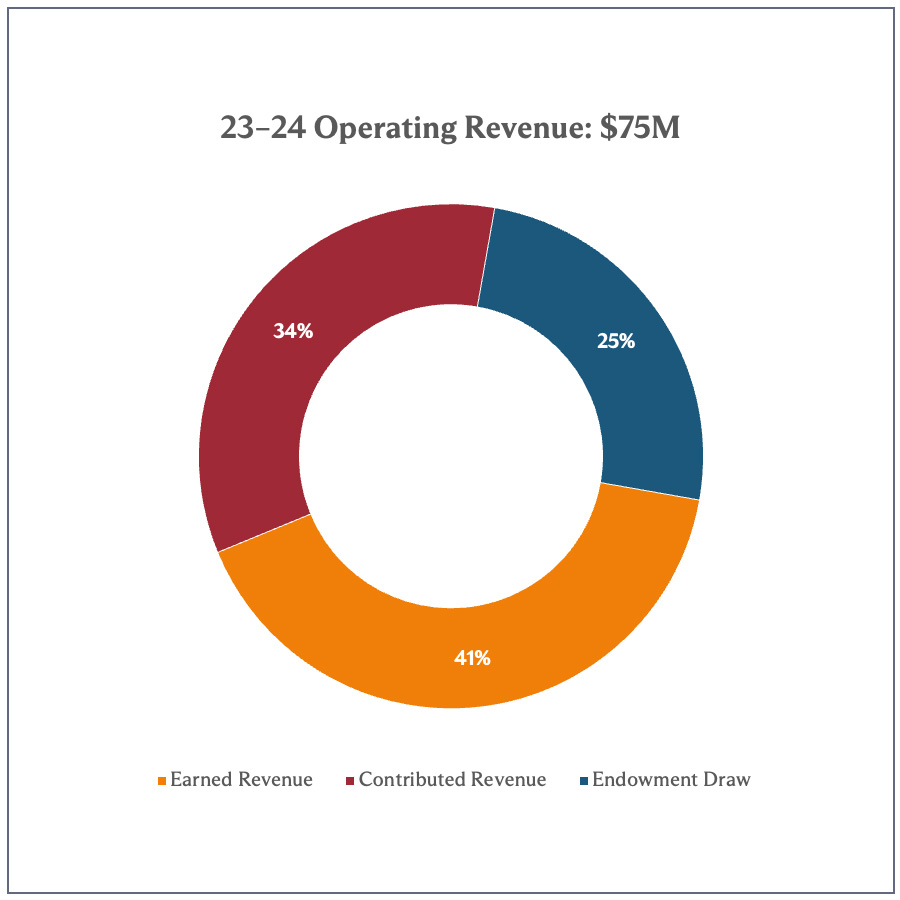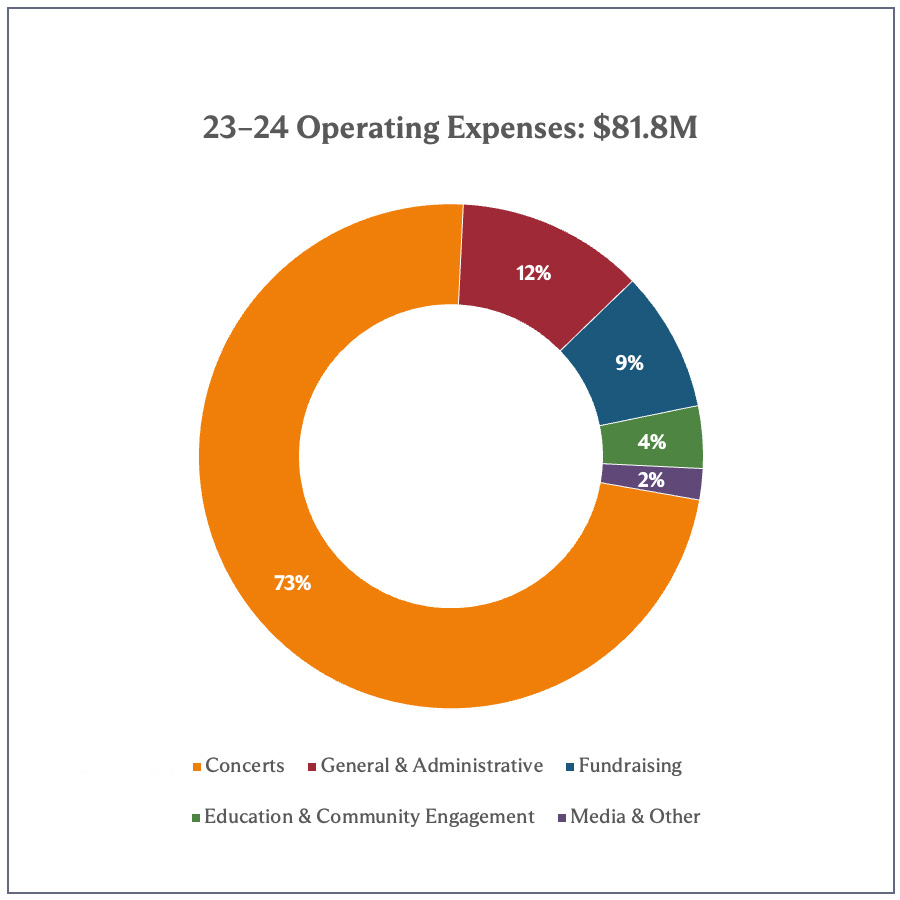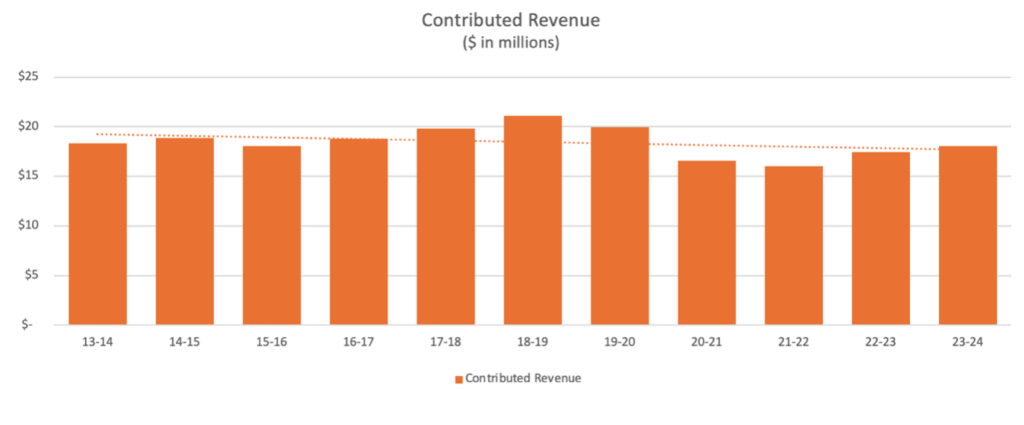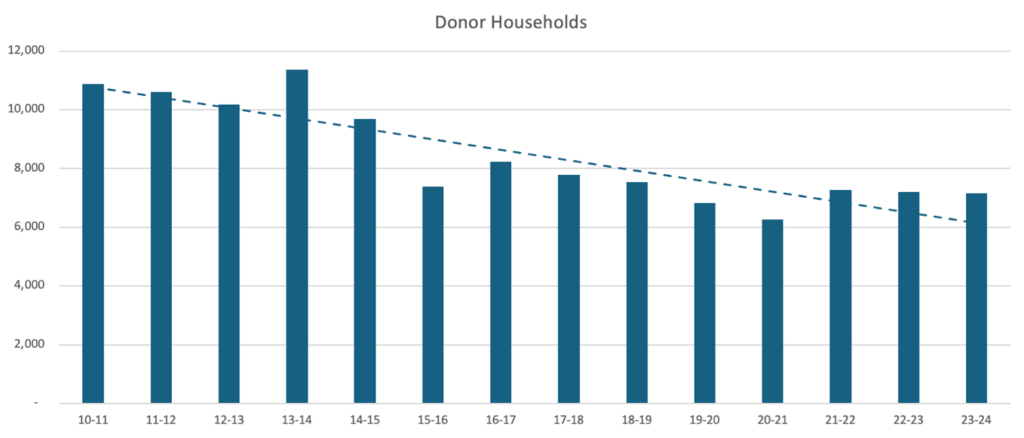Like all symphony orchestras, the San Francisco Symphony faces ongoing structural deficits where performance-related revenues do not cover performance-related expenses. To address these deficits, symphonies rely on other revenue sources such as philanthropic gifts and endowment draws. Below is a view of the San Francisco Symphony’s net operating deficit over the past 15 years. During this period, the Symphony has amassed $46M in cumulative deficits, funded in part through non-recurring sources, including a major one-time gift and the authorized drawdown—and near depletion of—the Board-controlled operating reserve.

*For more information about how this chart was calculated, please skip to the FAQ section at the bottom of this page.
During the pandemic, the Symphony received significant one-time financial aid, which helped sustain operations during an extended venue closure and restricted performances. This support was essential to the Symphony’s survival.
Throughout, the Symphony prioritized its artistic mission, investing nearly 3/4 of available revenue in concert activity. However, with the end of pandemic-related aid and the return of persistent deficits, the need to address the Symphony’s growing structural imbalance has become urgent.


Operating Revenue comes from three primary sources: Earned Revenue (primarily ticket sales), Contributed Revenue (donations), and an Endowment Draw.
Operating Expenses can be categorized into: Concerts, General and Administrative, Fundraising, Education & Community Engagement, and Media & Other.
Addressing the financial reality of persistent deficits requires both building revenues and focusing existing resources on the areas most critical to our mission. Our artistic excellence will always remain the top priority, with our musicians at the heart of everything we do.
The musicians for the San Francisco Symphony are exceptionally talented, and they are compensated accordingly. The average compensation for members of the Orchestra in 2024 was $225,821. Additionally, the Symphony provides the members of the Orchestra a choice of comprehensive medical insurance plans, as well as dental and vision insurance. The total average cost of medical, dental, and vision insurance coverage per Orchestra member was $36,698 in 2024, of which the Symphony pays 97%. Orchestra members receive 10 weeks of paid vacation annually and a maximum pension of $82,000 per year upon retirement. This compensation currently places the San Francisco Symphony musicians well within the “Top 7” group of our major orchestra peers.
The San Francisco Symphony’s Orchestra and operations are supported by a dedicated administrative staff. The average compensation for staff members was $124,282 in 2024. Administrative staff are offered a choice of medical insurance plans which are different from the Orchestra plans. The total cost of medical, dental, and vision insurance coverage per staff member was $21,193 in 2024, of which the Symphony pays 90%. Administrative staff receive between 3 to 5 weeks of paid vacation annually. There is no pension for administrative staff.
In the face of these challenges, the organization has already begun implementing a plan to change the financial trajectory of the organization and ensure artistic vitality well into the future. These are some of the tactical steps the Symphony is taking in service of achieving the artistic vision and future articulated on the Vision & Future page.
Phase 1: Cash Flow Stability
To work towards cash flow stability, the organization has already taken the following immediate actions:
Within this context, the San Francisco Symphony seeks to reach agreement with the American Federation of Musicians (AFM) on a contract that compensates the members of our Orchestra fairly, while managing expenses in accordance with available resources.
Phase 2: Rebuild Revenue Streams
Since the pandemic, the organization has been focused on rebuilding core revenue streams from ticket sales and annual donations.
Strategic changes to programming, concert format, marketing materials, and advertising strategy with a focus on stimulating new audiences have produced a significant post-pandemic rebound in tickets sales. However, even exceedingly robust ticket sales do not close the gap between revenues and expense. Increased philanthropy is also essential.

The annual fund, represented below, serves as the Symphony’s core fundraising for operating support, but it does not show the comprehensive philanthropic picture, which also includes revenue from special appeals, fundraising events, and legacy support, inclusive of endowment and planned gifts.

Increased donor engagement, more direct articulation of philanthropic need, and broader outreach efforts are currently focused on rebuilding the donor base that has decreased steadily for years. These efforts are underway but require both sustained commitment and time.

What is the San Francisco Symphony’s endowment and how does it support the organization?
The endowment is a collection of gifts from our dedicated supporters that was established in the earliest years of the Symphony with the goal of supporting the long-term financial health and artistic vitality of the organization well into the future. The endowment has been built through the generosity of generations of donors who have directed their gifts to ensure the Symphony’s long-term financial sustainability.
The endowment serves as a permanent funding source from which the Symphony takes an annual distribution (draw), creating a steady, predictable revenue stream that helps us plan for enriching artistic and educational initiatives. Alongside earned and contributed revenue, annual draws from the endowment represent one of the Symphony’s three primary sources of funding.
Why can’t the San Francisco Symphony use more of its endowment to cover annual deficits and budget shortfalls?
There is a common misconception that endowments can be accessed like a savings account and used to support operating expenses at any time. In reality, the Symphony’s flexibility in spending from the endowment is limited by uniform law (Uniform Prudent Management of Institutional Funds Act (UPMIFA) adopted by California in 1/1/2009), as well as by legally binding donor applied restrictions. UPMIFA addresses both the investment of donor gifts as well as what is considered prudent spending policy, i.e. the annual endowment draw to support operations. The Symphony must abide by UPMIFA, and honor donor mandated restrictions.
These donor mandated restrictions designate that endowment gifts be used exclusively for specific purposes. Contributions are often given in support of a specific artistic or educational program or initiative and draws from those funds must exclusively support those purposes. Approximately 55% of the Symphony’s endowed funds are subject to restrictions for purpose, leaving 45% not restricted for purpose but still subject to draw limitations imposed by California law.
How was the cumulative deficit chart on this page calculated?
In the Spring of 2024, the Symphony made a statement that noted a $116M cumulative deficit over the 10-year period from 2013-14 through 2022-23. This $116M deficit reflects Net Income from Operations less Endowment Investment Income, as included in the Symphony’s audited financial statements.
More recently, the Symphony focused on the $46M cumulative deficit for the 15-year period from 2009-10 through 2023-24 as shown on internal Operating Statements.
The primary distinction between these two charts is that the more recent document is based on internal Operating Statements which include annual draws from the Endowment and Board Designated Operating funds, which accounts for the vast majority of the difference.
These are both valid but very different ways to analyze the same data.